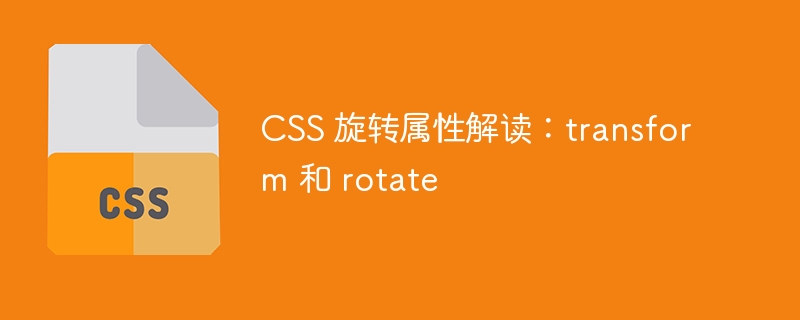Home >Web Front-end >CSS Tutorial >Interpretation of CSS rotation properties: transform and rotate
Interpretation of CSS rotation properties: transform and rotate
- WBOYOriginal
- 2023-10-20 18:02:441693browse

Interpretation of CSS rotation attributes: transform and rotate, specific code examples are required
Introduction:
In front-end development, CSS is often used to implement elements. Rotation effect. CSS provides a variety of rotation properties to choose from, including transform and rotate. This article will explain these two properties in detail and provide specific code examples to help readers better understand how to implement the rotation effect.
1. Transform attribute:
The transform attribute is a property in CSS used to change the appearance of elements. It can be applied to block-level elements and inline elements. There are many ways to get the value of the transform attribute, one of which is to use the rotate() function to rotate.
The syntax of the transform attribute is as follows:
transform: rotate(angle);
where angle represents the angle of rotation, which can be a positive number, a negative number, or a percentage.
The sample code is as follows:
<!DOCTYPE html>
<html>
<head>
<style>
.rotate-box {
width: 200px;
height: 200px;
background-color: lightblue;
transform: rotate(45deg);
}
</style>
</head>
<body>
<div class="rotate-box"></div>
</body>
</html>The .rotate-box class in the above code defines a square box with a width of 200px, a height of 200px, and a light blue background color. By adding the transform: rotate(45deg) attribute to the box, the effect of rotating the box 45 degrees clockwise is achieved.
2. Rotate attribute:
The rotate attribute is a sub-attribute of transform, which is specially used to control the rotation effect of elements. It can be used directly as a parameter of the transform attribute or used alone. The rotate attribute can only be used on block-level elements.
The syntax of the rotate attribute is as follows:
rotate: angle;
where angle represents the angle of rotation, which can be a positive number, a negative number, or a percentage.
The sample code is as follows:
<!DOCTYPE html>
<html>
<head>
<style>
.rotate-box {
width: 200px;
height: 200px;
background-color: lightblue;
rotate: 45deg;
}
</style>
</head>
<body>
<div class="rotate-box"></div>
</body>
</html>The .rotate-box class in the above code is the same as the previous example, but the rotate attribute is used instead of the transform attribute. By adding rotate: 45deg to the box's style, the effect of rotating the box 45 degrees clockwise is also achieved.
3. The difference between transform and rotate:
The transform attribute is a comprehensive attribute that can achieve a variety of transformation effects, including rotation, scaling, translation, etc. The rotate attribute is specifically used to implement rotation effects. Therefore, when you only need to implement the rotation effect, it is recommended to use the rotate attribute. The code is concise and easy to understand. When multiple transformation effects need to be implemented at the same time, comprehensive settings can be made through the transform attribute.
Conclusion:
Through the interpretation and sample code of this article, we have learned about the two properties of rotation effect in CSS: transform and rotate. Their respective applicable scenarios and usage methods are different. When using them, you should choose the appropriate attributes according to actual needs. At the same time, through practical operations and exercises, you can further master the implementation of rotation effects and improve your front-end development skills.
The above is the detailed content of Interpretation of CSS rotation properties: transform and rotate. For more information, please follow other related articles on the PHP Chinese website!

